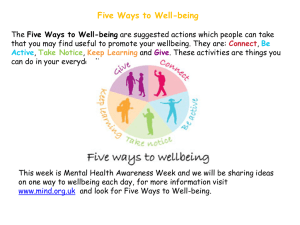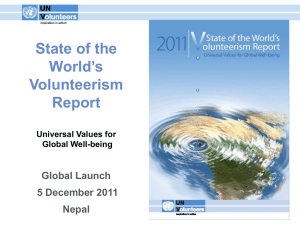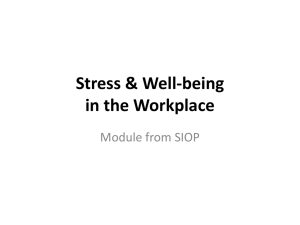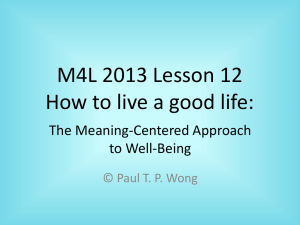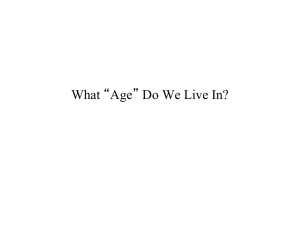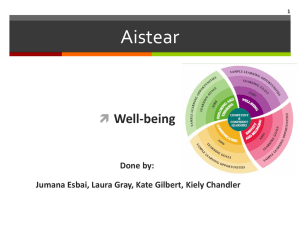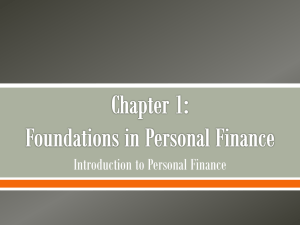here
advertisement
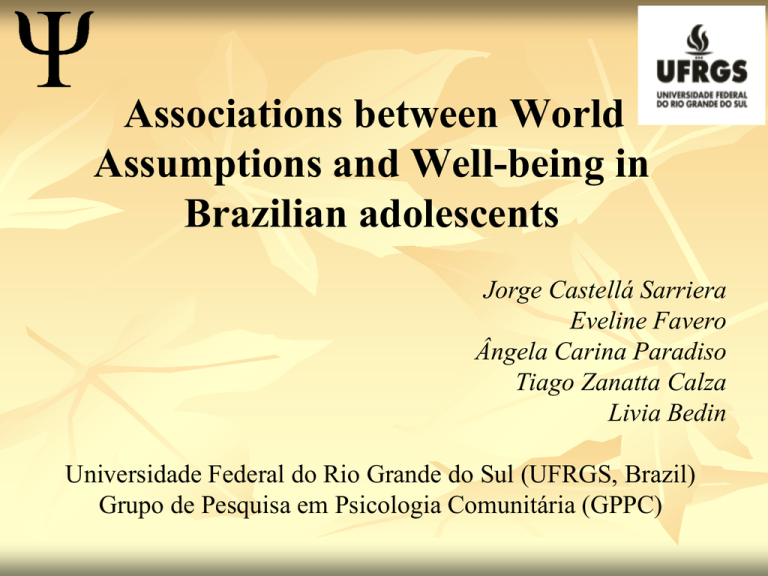
Associations between World Assumptions and Well-being in Brazilian adolescents Jorge Castellá Sarriera Eveline Favero Ângela Carina Paradiso Tiago Zanatta Calza Livia Bedin Universidade Federal do Rio Grande do Sul (UFRGS, Brazil) Grupo de Pesquisa em Psicologia Comunitária (GPPC) Introduction The research presented here is part of a research project: “Quality of Life and Well-Being in Adolescence”, which was funded by the Brazil Government´s, Ministry of Science and Tecnology, Conselho Nacional de Desenvolvimento Científico e Tecnológico (CNPq). The map below shows the cities which took part of the study in Brazil Introduction The world assumptions concept derives from the Assumptive World Theory A conceptual system developed during lifetime that provides us with expectations about the world and about ourselves This system is represented by general assumptions that drive our thoughts, reflect and guide our interactions Janoff-Bulman (1992) Introduction Personal Well-Being Conceptualized as feeling good or not, along the life cycle overall, not in occasional moments of life Can be understood as a reciprocal relationship between internal aspects (psychological) and its external interactions with other people and the context (psychosocial) Casas (2010); Cummins, Eckersley, Pallant, Van Vugt & Misajon (2003) Introduction Most research on world assumptions has been conducted with adults who have experienced traumatic events Arnoso et al., (2010, in press); Elklit et al., (2007); Jeavons & Godber (2005); Harris & Valentiner (2002); Magwaza (1999); Mikkelsen & Einarsen (2002) In a smaller proportion studies were conducted with adolescents, being even less common studies that assess relations between world assumptions and well-being Bègue & Muller (2006); Calhoun & Cann (2011); Feist, Bodner, Jacobs, Miles & Tan (1995) Introduction Aim of this study: To assess the relations between world assumptions and personal well-being of Brazilian adolescents Method Participants 1.589 adolescents from five cities in the state of Rio Grande do Sul (the state capital city and four other smaller cities of similar size) Ages ranged between 12 and 16 years old, with a mean of 14.13 (SD = 1.26) Method Instruments World Assumptions Scale (WAS) Originally consisting of 32 items measured with a 5-point Likerttype scale (from 1 = “strongly disagree” to 5 = “strongly agree”) Janoff-Bulman (1992) In this study it was used a reduced 16-items version of the WAS Páez, Arroyo and Fernández (1995) The WAS was measured by an 11-point Lickert-type scale labeled only at the extremes (from 0 = never to 10 = always). The increase in points on the scale is based on the idea that the measurement of aspects related to well-being can be better assessed by scales with more choice points Cummins (2003) Method Instruments World Assumptions Scale (WAS), adapted by Páez et al. (1995), consists of six factors: Benevolence of world and people: “If you look closely, you will see that the world is full of goodness.” Self-Worth: “I am very satisfied with the kind of person I am.” Justice: “Generally people deserve what they get in this world.” Luck: “I am luckier than most people.” Random: “Bad events are distributed to people at random.” Ilusion of control: “I usually behave in ways that are likely to maximise good results for me.” Method Instruments Personal Well-being Index (PWI) Assessment of people’s satisfaction with general aspects of life The PWI consists of seven items: satisfaction with health, living standards, what one has achieved in life, security, the groups of people one is part of, security about the future and the relationships one has with others Cummins et al. (2003) In this study, the PWI’s Cronbach’s Alpha was 0.78 Results Table 1. Exploratory Factors Analysis with Varimax Rotation of World Assumptions Scale (WAS), Alpha Coefficients and Variance Explained in this Study Factor Alpha Benevolence of world and people (items 03, 12, 15) 0.68 Self-Worth (items 10, 14) 0.81 Justice (04, 06, 07) Luck (05, 16) 0.47 Randomness (02, 08) 0.45 Ilusion of control (01, 09, 11, 13) 0.47 Variance Explained 0.60 60.8% Results Table 2. WAS Factors Associated with Adolescents’ Personal Well-being Personal Well-being Variable B Std Error Constant 46.658 1.968 Self-Worth 1.592 0.140 Luck 0.893 Illusion of Control Benevolence of World and People Justice Randomness R²aj.= 0,25 Beta t Sig 95% C.I. for B 23.714 0.000 [42.799, 50.518] 0.28 11.393 0.000 [1.318, 1.867] 0.133 0.17 6.700 0.000 [0.631, 1.154] 1.082 0.199 0.14 5.426 0.000 [0.691, 1.473] 0.773 0.168 0.12 4.612 0.000 [0.444, 1.101] 0.809 0.199 0.10 4.072 0.000 [0.419, 1.199 0.187 0.132 0.03 1.419 0.156 [-0.072, 0.446] Discussion The results confirm the hypothesis that world assumptions are associated with well-being (Feist et al., 1995) According to the results, Self-Worth is a contributor to the well-being of adolescents. This result underscores the results of other studies as Smedema, Catalano, Ebener (2010) where feelings of positive self-worth were found to be positively associated with subjective well-being This idea reinforces the importance of a positive self-concept that can lead adolescents to engage in appropriate behaviors, and maximize successful outcomes (Janoff-Bulman, 1992) thus contributing to the positive feelings of well-being Discussion Luck is linked to Self-Worth. We tend to measure ourselves as having more luck than most people within our particular world (Calhoun & Cann, 1994; Janoff-Bulman,1992) Janoff-Bulman (1992) also found in college students that they underestimate the likelihood of negative events happen and overestimate the positive events - what Weinstein and Lachendro (1982) called "unrealistic optimism" Discussion Related to Illusion of Control, Janoff-Bulman (1992) argues that the illusion of self-control is adaptive and not only positive emotions derive from it, but it also can improve the motivation to explore the world and engage in new behaviors, which is positive for adolescents According to Jeavons and Godber (2005), to believe in Benevolence of the world protects people from stress and anxiety, which could indirectly contribute to the well-being promotion. Discussion Related to Justice we tend to do, theoretically, a selective assessment of events which leads us to believe that certain events "make sense" (Janoff-Bulman, 1992) and thus interpret our world as meaningful According to Lerner´s Just World Theory, people have a need to believe in a just world because we feel deeply threatned by the possibility that negative events, if random, could happen to us (Lerner, 1980) Contributions This study emphasizes the importance of world assumptions as a predictor of Well-Being in adolescents These results reinforce the importance of psychosocial interventions that aim to strength the self-control and assertiveness This study contributes to test the use of WAS with adolescents, since the scale was designed for use with adult populations References Arnoso, M., Bilbao, M A., Páez, D., Iraurgi, I., Kanyangara, P., Rimé, B., Sales, P. P., & MartínBeristain, C. (2010). Violencia colectiva y creencias básicas sobre el mundo, los otros y el yo. Impacto y reconstrucción. In D. Paez, C. Martin Beristain, J. L. Gonzalez & J. De Rivera (Eds.), Superando la violencia colectiva y construyendo cultura de paz. Madrid: Fundamentos (in press). Bègue, L., Muller, D. (2006). Belief in a just world as moderator of hostile attributional bias. British Journal of Social Psychology, 45, 117-126. doi: 10.1348/014466605X37314 Calhoun, L.G., & Cann, A. (1994). Differences in assumptions about a just world: ethnicity and point of view. The Journal of Social Psychology, 134 (6), 765-770. Casas, F. (2010). El bienestar personal: Su investigación en la infancia y la adolescencia. Encuentros en Psicología Social, 5(1), 85-101. Cummins, R. (2003). Normative life satisfaction: Measurement issues and homeostatic model. Social Indicators Research, 64(2), 225–256. Retrieved from http://www.jstor.org/stable/27527122 Cummins, R., Eckersley, R., Pallant, J., van Vugt, J., & Misajon, R. A. (2003). Developing a national index of subjective wellbeing: The Australian Unity Wellbeing Index, Social Indicators Research, 64(2), 159–190. Retrieved from http://www.jstor.org/stable/27527119. Elklit, A., Shevlin, M., Solomon, Z., & Dekel, R. (2007). Factor structure and concurrent validity of the world assumptions scale. Journal of Traumatic Stress, 20(3), 291–301. doi: 10.1002/jts.20203 Feist, Gregory J., Tood E. Bodner, Jacobs, J. F., Miles, M., & Tan, V. (1995). Integrating top-down and botton-up structural models of Subjective Well-Being: A longitudinal investigation. Journal of Personality and Social Psychology, 68(1), 138-150. References Harris, H.N., & Valentiener, D.P. (2002). World assumptions, sexual assault, depression, and fearful attitudes toward relationships. Journal of Interpersonal Violence, 17(3), 286-305. doi: 10.1177/0886260502017003004 Janoff-Bulman, R. (1992). Shattered assumptions: Towards a new psychology of trauma. New York: Free Press. Jeavons, S., & Godber, T. (2005). Worl Assumptions as a measure of meaning in rural road crash victims. Australian Journal Rural Health, 13, 226-231. doi: 10.1111/j.1440-1584.2005.00706.x Lerner, M. J. (1980). The belief in a just world. New York: Plenum. Magwaza, A.S. (1999). Assumptive world of traumatized South Africans adults. The Journal of Social Psychology, 139(5), 622–630. Retrieved from: http://search.ebscohost.com.proxy.library.ucsb.edu:2048/login.aspx?direct=true&db=a9h&AN=2448 639&site=ehost-live Mikkelsen, E. G., & Einarsen, S. (2002). Basic assumptions and symptoms of post-traumatic stress among victims of bullying at work. European Journal of Work and Organizational Psychology, 11(1), 87–111. doi: 10.1080/13594320143000861 Páez, D.; Arroyo, E.; & Fernández, I. S. (1995). Catástrofes, situaciones de riesgo y factores psicosociales. Mapfre Seguridad, 57, 43-55. Smedema, S.M., Catalano, D., Ebener, D.J. (2010). The relationship of coping, self-worth and subjective well-being: a structural equation model. Rehabilitation Counseling Bulletin, 53 (3), 131142. doi:10.1177/0034355209358272 Weinstein, N. D., & Lachendo, E. (1982) Egocentrism as a source of unrealistic optimism. Personality and Social Psychology Bulletin, 8, 195-200. World Assumptions 01. Misfortune is least likely to strike worthy, decent people 02. Bad events are distributed to people at random 03. The good things that happen in this world far outnumber the bad 04. Generally people deserve what they get in this world 05. I am basically a lucky person 06. People’s misfortunes result from mistakes they have made 07. People don’t really care what happens to the next person 08. Life is too full of uncertainties that are determined by chance 09. I almost always make an effort to prevent bad things from happening to me 10. I have a low opinion of myself 11. Through our actions we can prevent bad things from happening to us 12. Most people are basically good and kind 13. I usually behave in ways that are likely to maximise good results for me 14. I am very satisfied with the kind of person I am 15. If you look closely enough, you will see that the world is full of goodness 16. I am luckier than most people Associations between World Assumptions and Well-being in Brazilian adolescents Jorge Castellá Sarriera Eveline Favero Ângela Carina Paradiso Tiago Zanatta Calza Lívia Bedin Universidade Federal do Rio Grande do Sul (UFRGS, Brazil) Grupo de Pesquisa em Psicologia Comunitária (GPPC) Website: www.ufrgs.br/gppc E-mail: gppc@ufrgs.br



